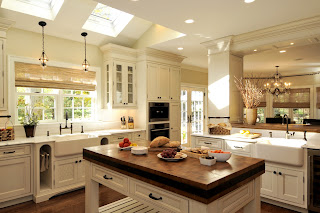Getting the lighting right not only ensures food preparation is easier (and safer) but can spell the difference between a warmer and welcoming room or a cold and sterile one.
Here's some thoughts on creating the perfect lighting design for your kitchen:
Light It Up: Ambient light is the overall light in your kitchen –that lights up all the vertical surfaces and fills in the shadows. If you have light colored surfaces and big windows, you may have enough ambient light during a sunny day—but since you use your kitchen on grey, rainy and winter days too, ambient light is very important. Whether your taste runs to something utilitarian, romantic or recessed, there are choices galore. Read on...
Center Stage: In the center of the ceiling, a large light is usually called for to light a bigger area. Recessed or track lighting is often used, but if you have fallen in love with a chandelier that would work in the space, make sure it has glass shades, as fabric gets too dirty from smoke, fumes and oils that a busy kitchen produces.
A Good Recession: Recessed lighting should be placed 30” away from any wall and can follow the entire perimeter of the kitchen, adding a lovely glow. Recessed downlights can be placed over the sink and stove. They create task lighting for cooking your gourmet meals (and all the pot scrubbing that follows that they never show on those celebrity chef shows.)
Take Them To Task: All task lighting is not recessed, however. Providing bright light with no shadows is the goal, however, so place whatever fixture you choose as close to the work area as possible.
Accent Lights: If it is a specific item you are highlighting (your grandmother's vase, for example) you may want to use incandescent lights. Consider halogens (usually called MR 16s) as these have a strong beam (and cast hard shadows which makes them a bad choice for task lighting but a great choice for accent lighting).
Down Below: Undercabinet lights can be a fabulous addition to lighting your countertops. Placed at the front of the cabinets instead of the back near the wall, these under-cabinet lights will light the countertop area evenly. You may choose miniature track lights, low-voltage linear systems or even energy-efficient fluorescents (as they won't be seen directly.) Use LED downlights as strips inside of cabinets to highlight collectibles or china and consider using both up and downlights as accents to give the illusion of more space than actually exists. You may want to use these strip lights to accent the toe-kick spaces or any niches too ( just be careful not to end up looking like an airport runway.) Remember, the further away from the wall you place the lights, the better the illumination. Consider using a dimmer on these lights separate for the other lights in your kitchen—it will not only save energy, but add drama to the space.
Jewels From Above:
You probably use your kitchen table or island for everything from homework to rolling out pie dough. Pendant lights work well to light such areas. Mount the pendant 30” above the table or island top. If your table is round, it will look best if the fixture is a foot narrower that the diameter of the table. For square tables or rectangular islands choose a fixture that is a foot narrower than the smallest side. A group of miniature pendants would also work well. Mount each pendant so that the bottom of the shade is approximately 66" above the floor, so the view across the room is not cut off. If you are going to seat people at the kitchen island and the pendant shades aren't too deep, install the pendants 60" above the floor.
You should have a pendant for every two feet of space of the surface it is lighting and use an odd number of lights instead of an even number for better balance. If the pendant are really narrow, it might look better to add a few more.
Or, if you have a pot rack over your island, consider installing lighting within the rack to shine down on your island—such concealed lighting can be a crafty way to add more light. For the lighting over your table or island, you might (again) want to consider using a dimmer. It adds options for when you are either dining at the table or setting out a lovely buffet on the island.
Jason Landau is an award-winning kitchen designer with extensive experience in lighting design. Jason and his team at Amazing Spaces, LLC will not only consult with you as to the type and placements of lights in your new kitchen, but share with you the latest fixtures from the hottest lighting vendors—providing you with a positively “illuminating” experience. Visit Amazing Spaces, LLC at www.amazingspacesllc.com or call 914-239-3725.




